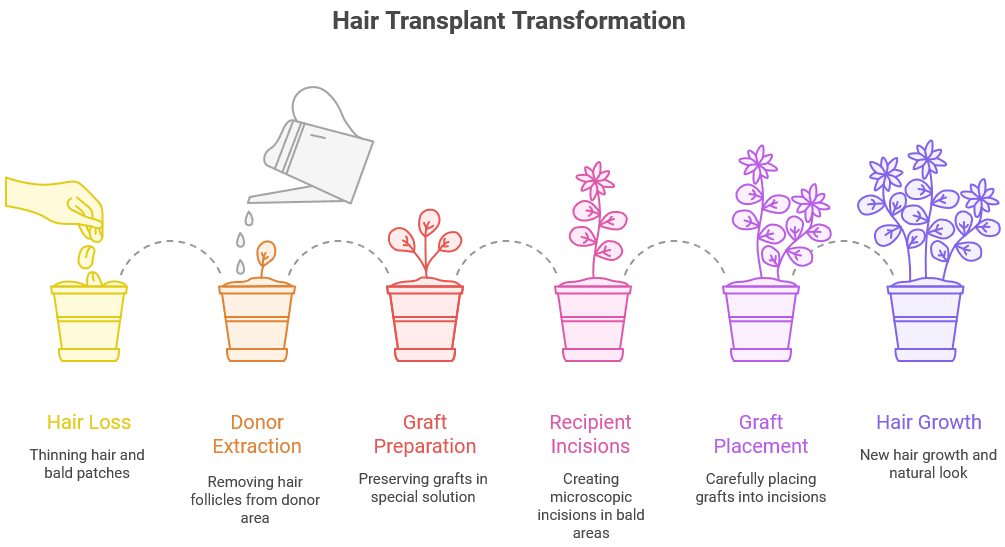Most people are aware that there is a highly successful and minimally invasive treatment for hair loss. However, they still have some reservations and important questions about the different procedures. The most common one seems to be about whether hair transplant surgery is considered a permanent solution and if the results will slowly fade over time.
To give a more precise answer, we have to explore the different types of operations, the results, why finding the right clinic is so important, and what to look out for.
Did you know?
According to the 2025 ISHRS Practice Census, the average number of grafts used in a first hair transplant procedure is 2,347, with 67.3% of patients achieving their desired result in just one session. . This suggests that modern hair transplant techniques can deliver lasting results with minimal interventions.
Are Hair Transplants Permanent?
In a nutshell, yes, the operation provides long-term results, but there are a number of factors that can affect the final look and whether it changes in the upcoming years and decades. The skill level and experience of the surgeon are big ones, and so is proper post-op care and protecting the head from direct UV light during the first few months.
In general, the transplanted follicles are more resistant to balding than the existing hair on the top of the head and will keep growing for a long time.
How Hair Transplants Work
The only option for patients with male pattern baldness before the early 2000s was Follicular Unit Transplantation (FUT), which involved removing a strip of skin from the back of the head and breaking it down into grafts that were then implanted into the bald areas. Although the results were long-lasting, the procedure offered limited density, looking a bit like a doll’s hair, and left the patient with a long horizontal scar.
Fast forward a couple of decades, and we have now perfected the new Follicular Unit Extraction (FUE) technique. The surgeon injects local anaesthesia into the scalp and uses a micro punch to extract individual hair follicles from the donor area, leaving only tiny, almost invisible scars.
FUE | FUT | |
Best for | Precise hairline design. | Larger areas that need more grafts in one session. |
Scarring | Minimal, almost invisible with short hair. | Linear scar at the donor site. |
Graft Survival Rate | 90–95% | 95–98% |
Healing Time | 7–10 days | 10–14 days |
The grafts are preserved in a special solution while the doctor uses a steel or artificial sapphire blade to make several thousand microscopic incisions in the recipient area, where they then proceed to carefully place the grafts.
What Results Can You Expect?
The follicles from the donor area will need about two weeks to fully heal, and you can expect noticeable new hair growth within six to eight months, with the final results being visible after a year. The new grafts will quickly take root and strengthen over time, making the transplant permanent and offering a more voluminous, natural look.
Can You Lose Transplanted Hair Over Time?
While the new strands will continue to grow for years after the hair transplantation procedure, and are much less susceptible to balding, the surrounding areas may continue to thin out and shed. Improper aftercare and high stress can also lead to infections and shock loss, so you have to be careful.
Best Candidates for a Hair Transplant
The most suitable patients are generally men and women in their early thirties to mid forties, who still have plenty of healthy hair left at the back of the head.
Choosing the Right Clinic and Surgeon
When looking at different clinics, be sure to check their experience and track record. The top doctors perform thousands of hair transplant surgeries, and you can find lots of reviews, patient testimonials, and before-and-after pictures.
These are all good signs, but be sure to ask additional questions during your initial consultation—reputable clinics are always transparent about their methods, pricing, and packages.
What to Expect After the Procedure
Every person is a bit different, but there is a general timeline that fits most cases. For the first 3–4 days after your hair transplant in Istanbul, you won’t be able to wash your hair or wear a hat, and it will take two full weeks for the scabs to fall off and the new hair to strengthen.
At this point, you will need to wear loose-fitting hats when going outside to protect your head from the sun and be careful not to pull your hair, but you can return to your normal lifestyle. Most of the new hair will fall out by about one month after the operation, but this is normal, as the follicles enter the resting phase.
After a few months of patchy growth, you will finally have a full head of hair some 8 to 12 months in, and there should be no major changes for the next several years.

How long do hair transplants really last?
A good transplant can last for the rest of your life, though you may need extra treatments like PRP or Minoxidil to prevent the rest of your hair from thinning over time. Some people get an additional treatment after a decade or so as a touch-up.
Is it normal for hair to fall out after a transplant?
Yes, after the first four weeks, most of the new hair will fall out on its own. There’s no reason to worry, as it is just making room for a new growth phase, which will take another few months.
Will I need more than one hair transplant?
If you get your first session relatively early, e.g., in your 30s, you may need to have one or two sessions later on, in your 40s or 50s, to fill out any further hair loss in the surrounding areas.
Can a hair transplant fail?
While the success rates are incredibly high at the top clinics, around 95% to 98%, there are still plenty of less experienced doctors out there who can make mistakes, so choose a reputable option like Asli Tarkan.
Are the results natural-looking?
Yes, you can expect a fairly dense look with a carefully designed hairline that fits your facial features, especially if you go with modern Sapphire FUE and DHI techniques.

